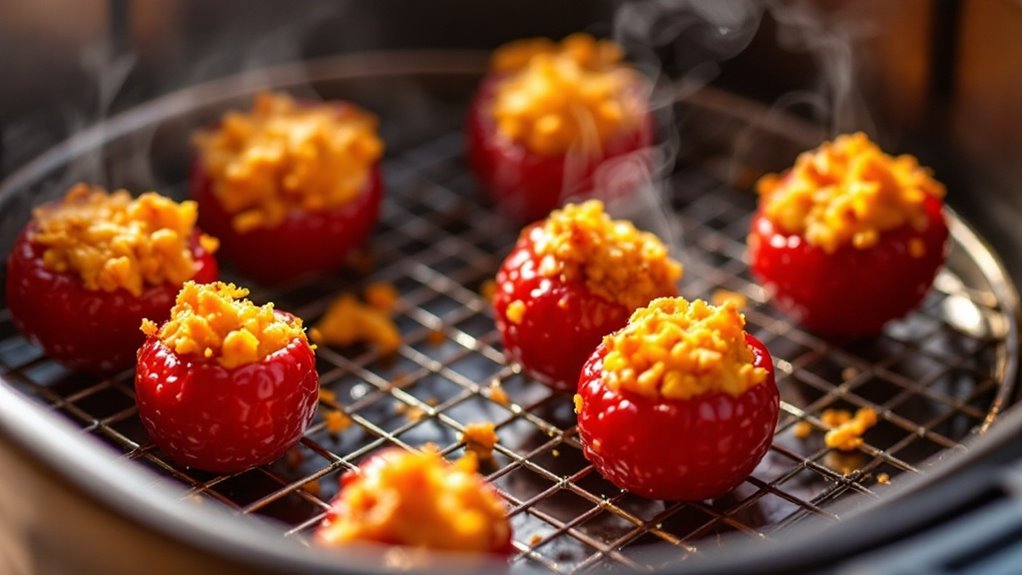To make air fryer taro tostones, you'll start by peeling and slicing the taro into rounds, then soaking them to remove excess starch. After patting them dry, you'll preheat your air fryer and lightly oil the slices before the first fry to soften them. But the real magic happens when you flatten the slices and fry them a second time—this is where they transform into crispy, golden perfection. The final step, seasoning, is where you can get creative. What spices or dips will you choose to elevate this dish? The possibilities are waiting for you to explore.
Key Takeaways
- Peel and slice taro into 1-inch rounds, soak in water for 15–30 minutes, then pat dry thoroughly before air frying.
- Preheat air fryer to 375°F (190°C) and cook taro slices for 8-12 minutes, flipping halfway, until softened.
- Flatten softened taro slices to ¼-inch thickness using a flat-bottomed object or press, ensuring even pressure.
- Air fry flattened slices at 375°F for 8-10 minutes, flipping halfway, until golden brown and crispy.
- Season warm tostones with salt or spices, and serve immediately with dips like lime crema or garlic aioli.
Gather Your Ingredients and Tools
Before you begin, make sure you've got all your ingredients and tools ready. Start with ingredient preparation: you'll need two medium taro roots, a neutral oil like avocado or vegetable oil, and a pinch of salt for seasoning. Verify the taro roots are firm and free of blemishes. For tool selection, grab a sharp chef's knife, a sturdy cutting board, a vegetable peeler, a mixing bowl, and your air fryer. You'll also need a kitchen towel or paper towels to pat the taro slices dry. Having everything within reach streamlines the process and prevents interruptions. Double-check that your air fryer basket is clean and ready for use. Proper preparation guarantees efficiency and precision, setting the stage for perfectly crisp taro tostones.
Peel and Slice the Taro Root
Using a sharp vegetable peeler, carefully remove the skin from the taro roots, making sure you eliminate any fibrous or uneven patches. Taro preparation requires precision, as the root's surface can be slippery and uneven. Rinse the peeled taro under cold water to remove any residual dirt. Pat it dry with a clean kitchen towel. For slicing techniques, use a sharp chef's knife to cut the taro into 1-inch thick rounds. Aim for uniform slices to guarantee even cooking. If the rounds are too large, halve them for manageable pieces. Avoid cutting them too thin, as they'll lose their structure during frying. Work quickly to prevent oxidation, which can cause discoloration. Proper taro preparation and slicing techniques are key to achieving perfectly crisp tostones.
Soak the Taro Slices in Water
Place the taro slices in a bowl of cold water to prevent browning and oxidation, ensuring they stay fresh and vibrant. Soaking them for 15–20 minutes helps remove excess starch and bitterness, which enhances their natural flavor and texture. This step also prepares the slices to crisp up beautifully in the air fryer.
Prevent Browning and Oxidation
To prevent browning and oxidation, submerge the taro slices in a bowl of cold water immediately after cutting them. This step halts chemical reactions caused by exposure to air, which can turn the taro an unappealing gray or brown. The water acts as a barrier, preserving the taro's natural color and freshness. For best results, let the slices soak for at least 10 minutes, ensuring they're fully covered. This simple technique is a key part of food preservation, maintaining the taro's visual appeal and quality. If you're preparing multiple batches, keep the slices in water until you're ready to cook them. Drain and pat them dry thoroughly before air frying to avoid excess moisture, which can affect the cooking process.
Enhance Texture and Crispiness
Soaking the taro slices in water not only prevents browning but also plays a significant role in achieving the desired texture. Submerge the slices in cold water for at least 30 minutes to soften their structure, guaranteeing they crisp evenly in the air fryer. This step helps maintain the right batter consistency when you coat them later, preventing clumping or uneven frying. After soaking, pat the slices dry thoroughly to avoid excess moisture, which can lower the oil temperature during cooking and result in soggy tostones. Properly dried slices will crisp up beautifully, creating a golden, crunchy exterior while keeping the inside tender. This technique secures your tostones have the perfect balance of texture and crispiness, elevating your dish to a professional level.
Remove Excess Starch and Bitterness
While soaking taro slices in water enhances texture, it also serves a dual purpose by removing excess starch and bitterness. After slicing the taro into even pieces, submerge them in a bowl of cold water for at least 30 minutes. This step guarantees effective starch removal, preventing the slices from becoming gummy during cooking. The water will turn cloudy as the starch leaches out, so drain and replace it halfway through soaking for better results. Soaking also aids in bitterness reduction, as it draws out natural compounds that can impart an unpleasant taste. Pat the slices dry thoroughly with a clean kitchen towel before proceeding to the next step. This simple yet vital process guarantees your taro tostones achieve a balanced flavor and perfect crispiness.
Preheat the Air Fryer
Set your air fryer to 375°F, the ideal temperature for achieving crispy taro tostones. Allow it to preheat for 3-5 minutes, ensuring the cooking chamber reaches the desired heat evenly. This step guarantees a golden, crunchy exterior while keeping the interior tender.
Optimal Temperature Setting
To achieve perfectly crisp taro tostones, preheat your air fryer to 375°F (190°C). This temperature guarantees the exterior crisps evenly while the interior remains tender. Maintaining temperature accuracy is vital; too low, and the tostones will turn soggy, too high, and they may burn. Modern air fryers excel in energy efficiency, so preheating won't waste power. Set the dial or digital display to the exact temperature, allowing the appliance to stabilize before adding the taro slices. This step guarantees consistent heat distribution, which is key for achieving that golden, crunchy texture. Avoid overcrowding the basket, as it can disrupt airflow and compromise results. By preheating correctly, you'll maximize both cooking performance and energy efficiency, setting the stage for flawless tostones.
Preheating Time Duration
Once your air fryer reaches the target temperature of 375°F (190°C), it typically takes about 3 to 5 minutes to preheat fully, depending on the model. Preheating guarantees temperature accuracy, which is vital for achieving evenly cooked, crispy tostones. Skipping this step can lead to inconsistent results, as the air fryer needs time to stabilize at the desired heat. The preheating benefits include faster cooking times and better texture, as the taro slices will start crisping immediately upon contact with the hot air. Always check your air fryer's manual for specific preheating recommendations, as some models may vary. Once preheated, you're ready to cook your taro tostones to golden perfection. This step guarantees your dish turns out just right every time.
First Air Fry: Soften the Taro Slices
After peeling and slicing the taro into even rounds, you'll want to lightly coat them with oil to make certain they don't dry out during the initial air fry. Arrange the slices in a single layer in the air fryer basket, making sure they don't overlap for even cooking. Set the air fryer to 375°F and cook for 8-10 minutes, flipping halfway through. This first fry is vital for taro preparation, as it softens the slices, making them pliable for the next step. The heat breaks down the starches, transforming the firm texture into a tender, slightly golden base. Use tongs to check for doneness—they should yield slightly when pressed but not fall apart. Proper softening techniques make sure your tostones have the right foundation for crispiness later.
Flatten the Taro Slices
While the taro slices are still warm from the initial air fry, transfer them to a flat surface and use a sturdy, flat-bottomed object—like a glass or a tortilla press—to gently flatten each slice. Apply even pressure application to guarantee the slices compress uniformly without breaking apart. The flattening technique requires a delicate balance: press firmly enough to create a thin, even layer but avoid crushing the taro's starchy structure. If the slices cool too much, they'll resist flattening, so work quickly. Aim for a thickness of about ¼ inch, which allows for ideal crispiness later. If the slices stick to your tool, lightly grease it or place a piece of parchment paper between the taro and the press. This step guarantees the tostones have the perfect texture for the next stage.
Second Air Fry: Crisp the Tostones
Preheat your air fryer to 375°F (190°C) and arrange the flattened taro slices in a single layer, making sure they don't overlap. Lightly spray or brush them with oil to promote even crisping. Air fry for 8-10 minutes, flipping halfway through, until golden brown and crispy. Monitor closely to avoid overcooking, as taro can burn quickly. Use these air fryer tips: shake the basket gently to guarantee consistent heat distribution and avoid overcrowding, which can lead to uneven results. This cooking technique locks in texture while achieving a satisfying crunch. Let the tostones cool slightly on a wire rack to maintain crispness. Proper timing and temperature control are key to perfecting this step, securing your taro tostones are golden, crisp, and ready for seasoning.
Season the Taro Tostones
Once the taro tostones have cooled slightly but are still warm, transfer them to a large bowl or plate. Sprinkle them generously with salt while they're warm to help the seasoning adhere. For classic flavor pairings, try a mix of garlic powder, smoked paprika, and a pinch of cayenne for a smoky, spicy kick. If you prefer tangy notes, toss them with lime zest and chili powder. For seasoning variations, experiment with furikake for an umami twist or a blend of cumin and coriander for a warm, earthy profile. Lightly drizzle with olive oil or spritz with cooking spray to help the spices stick. Gently toss the tostones to guarantee even coating, being careful not to break them. Adjust seasoning to taste, keeping in mind their natural earthy flavor.
Serve and Enjoy Your Taro Tostones
After seasoning your taro tostones to perfection, serve them immediately while they're still warm and crispy. Arrange them on a platter or in a bowl, ensuring they're easy to grab. Pair them with bold flavor pairings like tangy lime crema, spicy sriracha mayo, or a zesty garlic aioli for dipping sauces that elevate their earthy sweetness. For a revitalizing contrast, try a cilantro-lime yogurt dip or a smoky chipotle sauce. Garnish with fresh herbs like cilantro or a sprinkle of flaky sea salt for added flair. Enjoy them as a snack, appetizer, or side dish alongside grilled meats or tropical salads. Their crispy exterior and creamy interior make them irresistible, so savor each bite while they're at their peak.
Disclosure: As an Amazon Associate, I earn from qualifying purchases.



